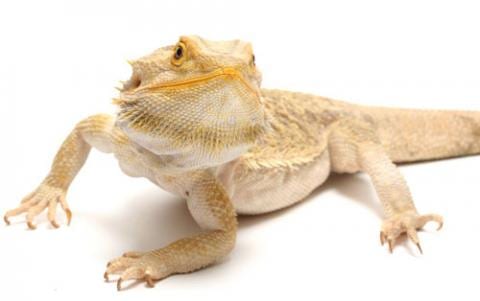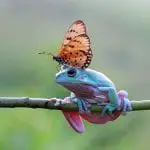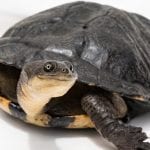A bearded dragon is an omnivore, which means it will eat plants and animals. This lizard needs a varied diet, and the options available for your pet make this a fun lizard to feed.
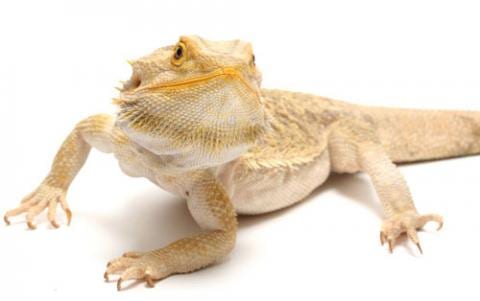
Bearded dragons can eat a wide variety of live food such as mealworms, crickets, and kingworms. These lizards will also eat veggies and fruits like sweet potato, peppers, leafy greens, parsley, and kale. Meanwhile, wild bearded dragons eat mainly animals and insects make up around 75% of their diets. The most popular items on a wild bearded dragon’s menu include worms, cockroaches, vegetables, and crickets. You may even find bearded dragons eat small mice. The remaining 20% to 25% of their diet is made up of fruits and veggies.
Your responsibility as an owner
The diet of a captive or pet bearded dragon must be at least very similar to their diets in the wild. This must be varied as well, and this means it must-have vegetables, meat, fruit, and greens. But as your bearded dragon becomes older, it will need to cut down on meat as he won’t be getting enough exercise compared to when it was younger. Eating too much meat can make your lizard obese or overweight.
Bearded dragon food is easily available from a local pet store. Most pet stores carry live crickets, mice, mealworms, and roaches. And when it comes to veggies and fruits, a simple trip to the grocery store may be enough to haul your pet’s food for the next few weeks!
Meat sources for bearded dragons
- Butterworms
- Cockroaches
- Crickets
- Crickets
- Dubai roaches
- Earthworms
- King worms
- Locusts
- Mealworms
- Phoenix worms
- Silkworms
- Superworms
Take note that mealworms should only be fed to adult bearded dragons because this has a hard outer cover or skin. A tough insect like this can impact the digestive system of young dragons and may also lead to impaction. Meanwhile, super worms are larger mealworms and thus must be fed only to adult dragons.
Choose only organically-raised insects because wild-caught insects may contain chemicals like pesticides and herbicides that can harm your pet in the long run.
How to prepare this kind of food?
- Buy your food from a reputable pet lizard food dealer. You’ll surely be surprised by the many options you have.
- You may also opt to take care of insects for your pet lizard. This way, your pet can have an unlimited supply of food that is free from pesticides and other chemicals.
- You may use insects, mice, and other live food as a way to supply nutrients to your pet by gut-loading.
For live insects that have drowned in the water dish of your pet, remove these right away. Your pet won’t eat this, and it will just rot and bring unwanted bacteria inside the tank.
Fruit sources for bearded dragons
- Apples
- Apricots
- Apricots
- Dates
- Figs
- Grapes
- Guavas
- Kiwi
- Mangoes
- Melons
- Papayas
- Peaches
- Pears
- Plums
- Raisins
- Strawberries
Most of the fruits in this list are hard fruits. Soft fruits should be given in fewer amounts because these usually have higher sugar content. Sugars can ferment in the mouth and cause gum and teeth problems.
Again, organic fruits are the best to raise a healthy bearded dragon. And if you want, you can grow your own fruit without the use of chemicals such as pesticides and herbicides.
How to prepare this kind of food?
- Follow the rules of serving fruit for your family. Wash them first before giving to your pet. Better soak your fruits in water and a few tablespoons of apple cider vinegar for at least an hour.
- You can give small fruits to your dragon without cutting them up. Dates, raisins, strawberries, and grapes are easy to give and to swallow.
- Cut larger pieces of fruits and leave the skin for extra crunch. Cut large fruits to pieces the size of their eyes. Don’t let your pet see you cutting and fussing about its food because it might lose interest in what you’re about to serve him.
- Serve fruits as they are, or you may mix different fruits to make a salad. You can also freeze your fruits in small cups and add a dash of crème for a delicious fruity treat.
- Never give rotting, very soft, smelly, or deformed fruit to your pet. Discard these right away.
Vegetable sources for bearded dragons
- Acorn squash
- Asparagus
- Bell peppers
- Bok choi
- Brocolli
- Butternut squash
- Cabbage
- Celery
- Green beans
- Kohlrabi
- Okra
- Peas
- Sweet potatoes
- Yellow squash
Just like serving fruits, serve only fresh and safe veggies. Large chain supermarkets have an organic line where fruits are sold in safer and better.
You may also opt to grow your own veggies at home. This way, your pet has an endless supply of safe and organic food.
How to prepare this kind of food?
- Wash your veggies or, better yet, soak these in apple cider vinegar for about 15 minutes.
- Cut large leaves and vegetable pieces. Small veggies like peas and green beans don’t need to be cut or prepared.
- Make a delicious vegetable salad for your pet. Don’t just give it the same vegetable day after day. Think of ways to serve your veggies that your pet will love.
- Never give soft, rotting, or opened veggies to your pet. Discard these ASAP.
Greens sources for bearded dragons
- Clover
- Collards
- Coriander
- Dandelions
- Endive
- Kale
- Mustard greens
- Parsley
- Rocket
- Turnip greens
Never take any plant or greens from the outdoors. You can’t be sure if these are free from chemicals, pesticides, and dirt, which can affect your lizard’s health. Growing your own supply of green veggies is one way to have an endless supply of food for you, your family, and your precious lizard pets.
Your bearded dragon pets can occasionally eat sprouts, peas, grated carrots, bananas, cucumbers, and blueberries.
How to prepare this kind of food?
- Leafy green veggies are easy to prepare before feeding your pet. Cut the veggies into smaller pieces and wash them.
- These veggies have hard stems, but your pet will be happy to chew on these as well.
- Never give rotting, discolored green veggies to your pet. If you spot these, discard these right away.
Foods that your bearded dragon should stay away from
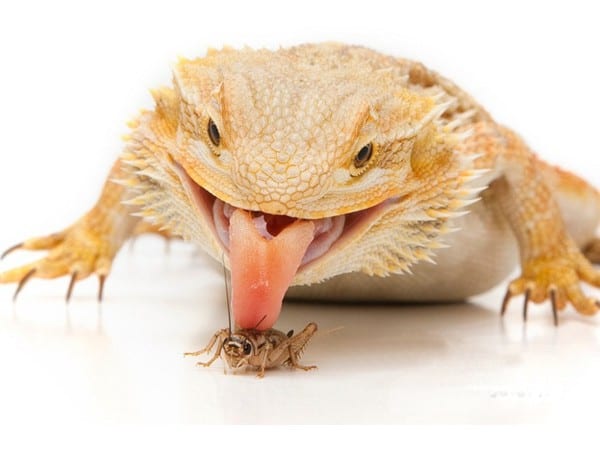
Probably the next question in your mind is what foods your bearded dragon won’t eat. To be on the safe side, stick with the food that is found on our list.
Keep in mind that your pet will also consume food that may be harmful to it, so it’s your responsibility as a pet owner to make sure that all the food that it eats is safe. And if for any reason your pet bearded dragon becomes sick, you must take it to the vet at once.
As far as most pet owners, vets and reptile specialists are concerned, never feed your pet bearded dragon the following:
- Iceberg lettuce – what seems like an innocent salad and sandwich staple, iceberg lettuce is simply full of water and has very little nutritional value and thus must not be given to your pet. It’s not that it’s poisonous or anything, but eating a lot of this will make them feel full and won’t eat food that is a lot more nutritious than lettuce.
- Beet tops and spinach – Most beet tops and spinach sold in markets contain chemicals which can lead to calcium deficiency. Low calcium levels can result in metabolic bone disease. You can give your pet these veggies but only in small amounts.
- Wild-caught insects – most wild-caught insects have parasites in them, and this can harm your pet. Also, it’s hard to find and capture wild insects anyway. So, it’s best to find a reputable pet shop where you can find clean, healthy, and nutritious insects for your pet to eat.
- Fireflies – any kind of glowing insect can be toxic to your pets. Even a small firefly can be toxic to your dragon, so never feed it one.
- Avocados – Avocados have natural chemicals that are dangerous to pet lizards. A small amount can make your pet ill, and eating a large one or the entire fruit can be fatal and may also lead to death.
- Rhubarbs – rhubarbs have high amounts of oxalic acid and thus can be very dangerous to your pet. This acid is poisonous to small pets like bearded dragons. Never give this even in small amounts.
- Seafood – Do not give your pet any kind of seafood like prawns and crabs. Do not give fish or any shellfish either.
- Wild plants – most wild plants contain high amounts of chemicals, while some are considered poisonous and should be avoided. Do not give your dragon fern, bracken fern, holly, daffodils, crocus, horse chestnuts, poppy, ivy, oak, and many others.
- Human food – Human food contains chemicals and additives that are very dangerous to pet lizards. Also, these foods are mostly high in fats that can lead to obesity or being overweight.
- Junk food – this food does not contain any nutrients and thus should be avoided. Junk food/human food can only upset the digestive system of your pet and can lead to diarrhea and other gastrointestinal illnesses.
- Other questionable food items – to be on the safe side, never give any kind of food that you are unsure of. If you are not familiar with a plant, fruit or vegetable offered to you, never give it to your pet bearded dragon. Commercially-prepared lizard food with no instructions or labels is also dangerous.
- Sand – calcium sand or any kind of sand can accumulate inside the body of your lizard, causing impaction and dangerous gastrointestinal conditions. Sometimes, eating sand cannot be helped, especially when you use it as a substrate. When food falls on the floor, it becomes coated with sand and your pet eats it. Later on, sand bits will accumulate inside the body causing terrible side effects.
How to feed baby bearded dragons?
For an adult bearded dragon, feed it only once a day with quality food. For baby dragons, these need food that is high in protein and should be fed more frequently than their older siblings and parents. You can feed a baby bearded dragon three times a day.
If you feed it vegetables and leafy greens, these young lizards will eat them whenever they are hungry. You can now add insects after 10 to 15 minutes for three successive feeding times. A baby dragon can eat more than 60 insects in a day, but after the mentioned eating interval, this will soon become full. After the feeding frenzy, remove all insects in the cage and start again next feeding time.
As your pet becomes older, feed it fewer insects to prevent becoming overweight. Gradually, increase feeding vegetables and fruits to your pet. Offer fresh chunks of fruits, veggies, and small cuts of leafy greens. Cut food into small bite-sized, easy to eat pieces before giving these to your pet.
What to feed young or juvenile bearded dragons
Some pet owners recommend feeding juvenile bearded dragons 50% insects and 50% plants, fruits, and vegetables. Young or juvenile bearded dragons will now require equal amounts of insects and plants, and thus, you may need a food scale or a measuring device to keep track of the amount of food that you will give to your pet.
As your pet becomes older, feed it one large insect once a day, and the rest of its food will now be vegetables, fruits, and greens. In the wild, bearded dragons will move a lot, will get a lot of exercises, which means that they can eat more meat in a day (more insects in a day).
Feeding your pet bearded dragon live food
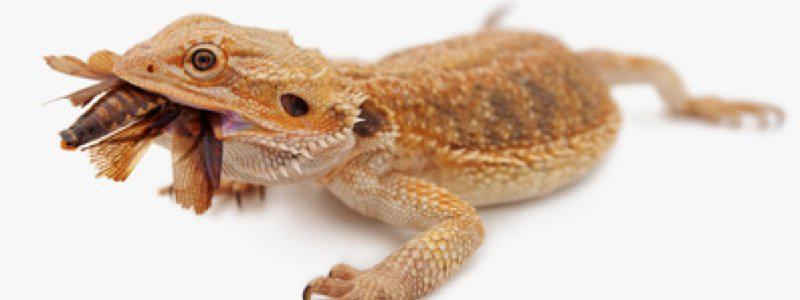
When it comes to living food, bearded dragons will consume more crickets and mealworms. You’ll find these in pet shops and pet stores. Live crickets are available anytime and are easy to give to your pet. Also, since the insect is alive, it will likely dart around, hop and move about to avoid being eaten. Your pet bearded dragon will likely move about too to chase after food, and this lets them exercise.
Crickets are sold by the number in most stores. A dozen crickets cost cheap, and usually, these are placed in small plastic containers with holes on them, and all you need to do is to get one cricket inside and place it inside the cage. You need to feed your insects too so these will stay nutritious as your dragon eats them. Give them leftover food, bread or a piece of fruit.
Feed crickets that will fit your dragon’s mouth. If cricket is bigger than the space between the eyes of your lizard, then it is too big. You may also dust your crickets with calcium supplements so your pet dragon can get his daily calcium supply.
Once you have dropped the crickets inside the cage, make sure that these don’t drown in the water bowl. If these do fall inside the bowl and drown, pick them up and discard them. Some pet owners place polymer crystals inside feeding bowls so that the crickets can walk over the bowl and won’t drown.
Another common live food for bearded dragons is mealworms. These are cheap and can be easily kept inside the fridge. When you place mealworms inside the fridge, they won’t freeze and die but rather enter a dormant phase. Mealworms have higher fat content, so don’t give your dragon too much. Usually, if you fill the food dish of your dragon with a lot of mealworms, it will continue eating everything, and this can make it fat.
If you intend to place live food in containers, put these containers in your garage or spare room because this will begin to smell after a while. Also, don’t keep live food like mealworms in the fridge for a long time since this will soon smell. Consume all the food first before buying new ones from the pet store.
Supplements for your bearded dragon
Calcium deficiency is a problem for most pet dragons and other reptiles because this can lead to metabolic bone disease. Even lizards with a good diet can suffer from MBD, and thus, feeding them supplements is a must.
You can buy calcium supplements for reptiles in most pet stores and from your vet. Just dust the live food with calcium dust and feed it to your pet. Dust their vegetables and fruits. Don’t mix your supplements and just give them every other day. For instance, give calcium supplements every Monday, Wednesdays, and Fridays and a multi-vitamin pill every Tuesdays, Thursdays, and Saturdays.
You can use calcium supplements with D3. Bearded dragons that are under 6 months will need supplements daily, but as they become older, you can reduce the number of supplements that they consume. Dragons that are between 6 months to a year need supplements daily. Older dragons need calcium every 2 to 3 days or vitamins two times a week.
Some owners don’t give D3 as they take their dragons outdoors to get natural sunlight.
Help! My bearded dragon is not eating!
If your dragon is sick or is shedding its skin, then it won’t eat no matter how much prodding you do. When this happens, watch out for other symptoms. For sick, non-eating dragons, monitor it for other symptoms like diarrhea, constipation, vomiting, poor energy, changes in gait, and movement.
When shedding, it won’t eat. It will retreat inside its sleeping or resting area and will remain there until all of it is skin is removed. Most of the time, dehydrated and stressed bearded dragons may not shed completely. Skin can remain along with the eyes, limbs, tail, and neck, and this can cause bruising, pain and a lot of stress! The last thing that your pet will want to do is eat.
For shedding worries, take your pet to the vet. Once shedding is over, feed your pet twice the amount it eats daily because it is probably very hungry. If your setup or enclosure is not good, then expect further problems, and this can also cause poor appetite and other health conditions.
Dragons that are in brumation can also lose appetites. Refusing to eat does not mean that something is wrong. Sometimes, a dragon is already full and thus may not eat for a day. If the dragon is too hot, then it may just drink. But if your pet is losing weight and is losing energy, then there must be something wrong.
As always, prevention is better than treating a sick dragon. Take your pet to the vet at once. Your vet will likely conduct tests like blood tests, stool tests, x-rays, and other tests to examine your pet and rule out any disease.
How to feed sick bearded dragons
If your dragon is sick, follow your vet’s advice on what food to eat and what not to feed it. If there is a medication prescribed by your doctor, follow the prescription closely. If your pet is dehydrated, cut down on solid food and use a syringe to feed your pet an electrolyte solution in their mouth.
If your bearded dragon is dehydrated, you may create a watery mixture of nutrients and food and feed your pet using a syringe or dropper. As it tolerates this mixture, slowly build up the solid portion of the mix until it can finally tolerate solid food.
But unless your vet plans to change your pet’s diet, you can give this mixture to your bearded dragon. Also, maintain the enclosure’s temperature and humidity levels and keep everything clean so your dragon can recuperate quickly.
Take your pet to the vet after a week or two just to make sure that it is already recuperating from its illness.
Talk to your vet about the best kind of food for your pet bearded dragon. Don’t forget to ask for supplements, especially for young and recuperating dragons.

